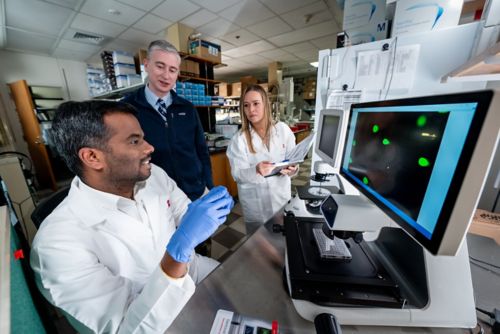St. Jude Family of Websites
Explore our cutting edge research, world-class patient care, career opportunities and more.
St. Jude Children's Research Hospital Home

- Fundraising
St. Jude Family of Websites
Explore our cutting edge research, world-class patient care, career opportunities and more.
St. Jude Children's Research Hospital Home

- Fundraising
Ribosome production presents a new therapeutic opportunity against Wilms tumor

(L to R) First author Prahalathan Pichavaram, PhD, corresponding author Andrew Murphy, MD, St. Jude Department of Surgery and co-author Carolyn Jablonowski, PhD.
Discover how disruption ribosomes creation provides promise for “undruggable” cancers
Industrial production has been a driving force for country-level growth and expansion over the last two centuries. From factory production utilized by the Union during the United States Civil War to the post-World War II economic boom in many countries to the growing economies marked by massive-scale production today — ramping up manufacturing capacity has been a key feature of success. One of the reasons tumors grow so successfully and are so difficult to treat is their protein manufacturing capacity, mirroring the benefits of nation-state industrial production at the cellular level.
Cancer cells are constantly dividing and growing. That engine must be consistently expanded — new proteins created to provide necessities to each cancer cell. Ribosomes are the protein factories of all cells. They are a hybrid molecule of RNA and protein that translates the language of messenger RNA, derived from the body’s genes, into proteins. About 85% of a cancer cell’s metabolism is devoted to ribosome biogenesis. Ribosomal biogenesis is the process of expressing ribosomal protein genes and ribosomal RNA (rRNA) subunit genes to create new ribosomes.
St. Jude researchers recently found that a drug created to inhibit the KDM4 histone demethylase family, called QC6352, could be effectively used against tumors with high levels of ribosomal biogenesis. The findings were published in Molecular Cancer Therapeutics.
“We figured out this compound shuts down ribosome biogenesis of kidney-derived cancer cells,” said corresponding author Andrew Murphy, MD, St. Jude Department of Surgery. “We showed that [QC6352] shuts down the transcription of the ribosomal protein genes and rRNA and causes a blockade of new protein synthesis.”
The lab was investigating if QC6352 could be used to treat the most common childhood kidney cancer, Wilms tumor, and another tumor-forming cell line derived from an embryonal kidney lineage. While their initial hypothesis held that these embryonal kidney cell lines and xenografts would be sensitive to the drug, they found that the results were potentially more far-reaching.
“First, we saw that cancer cells with an embryonic kidney origin had a different or unique response to QC6352 compared to other contexts where it’s been studied before,” Murphy said. “Then, our careful study of two kidney-derived cell lines revealed a mechanism that may mean that a broader set of tumors, those with high expression of ribosomal genes at baseline, could be reasonable targets for this compound.”
When the group tested over 900 cell lines with the compound, more cells responded than expected, including those not derived from embryonal kidney cells. Instead, sensitivity was based primarily on ribosome biogenesis activity.
Stopping cancer’s ribosome production by blocking regulator KDM4A
Many pediatric cancers are difficult to treat with targeted therapies, as there are few genetic causes. Instead, drivers tend to be epigenetic, affecting transcription factors and other proteins that directly bind DNA. As transcription factors cannot be directly targeted by drugs, treating these cancers with targeted therapy can be impractical.
One way around this challenge is to identify drugs that target proteins downstream of a transcription factor’s activity. The transcription factor results in the expression of certain proteins. Those proteins then affect downstream proteins with related purposes, all working as a pathway toward a specific cellular function, such as growth. Murphy’s team found that the protein lysine-specific demethylase 4A (KDM4A) is one such protein (the letter ‘K’ is a shorthand representation of the amino acid lysine).
“The anti-tumor effects of QC6352 were mediated through KDM4A, one of the histone demethylase family members the compound targets,” Murphy said. “We also showed that KDM4A is localized to the nucleolus, where ribosome biogenesis is initiated and completed. That gave us the overall story: QC6352 inhibits KDM4A, which in turn impairs ribosome biogenesis in these sensitive cell lines.”
If ribosomes are the cell’s factories, KDM4A is the permit office in certain cells. In these cells, the genes that encode ribosomal components can only be accessed and start the assembly of these cellular factories if KDM4A gives its permission through its catalytic activity.
KDM4A is a demethylase, an enzyme that affects the histone proteins that spool DNA and determine how DNA is accessed and expressed. When this demethylase acts, it removes a repressive mark from histones, opening up that region of DNA to be accessed by gene expression machinery. In some types of cancer, KMD4A is co-opted to maximize ribosomal biogenesis by removing repressive markers from ribosomal genes.
In fact, when the St. Jude group inhibited KDM4A, over 200 genes related to ribosome biogenesis had decreased expression. The ribosomal factories aren’t built in the treated cancer cells, starving tumors of the proteins they need.
Degrading KDM4A
All cells have a normal trash system that they use to get rid of proteins that are dysfunctional or no longer needed. This degradation system requires that proteins be labeled appropriately so the cell knows it’s intended for the trash. The proteasome is a cellular trash collector, gathering dysfunctional or obsolete proteins and breaking them down. The proteasome reads chemical labels placed on unwanted proteins. These labels are a protein called ubiquitin. Over time, proteins can be labeled several times by ubiquitin, creating a strong signal for the proteasome to destroy them. Cancer can manipulate this process to its benefit.
“We found QC6352 causes KMD4A degradation via the proteasome,” Murphy explained. “So not only does this compound bind KDM4A to prevent its activity, but it also tags the protein for ubiquitination and degradation.”
Adding QC6352 accelerated the natural turnover rate of KDM4A, thus lowering the amount of it in the cell and stymying its activity. Lower KDM4 levels result in lower ribosomal biogenesis, which prevents cancer cells from ramping up their ribosomal manufacturing capacity and reduces their survival. This work is proof-of-principle that manipulating ribosomal production could be a useful anti-cancer approach.
The future of targeting cancer’s ribosomal biogenesis
While targeting the epigenetic variants that drive cancer may not be possible in many pediatric cancers, this research demonstrates that removing cancer’s manufacturing capacity might be a workaround.
“Before this paper, inhibiting KDM4A with this compound and therefore impairing ribosome biogenesis would not be at the forefront of any oncologist or researcher’s mind,” Murphy explained. “Hopefully, now the field will explore the ribosome in the context of cancer therapy for pediatric renal tumors or other cancers with high levels of ribosome biogenesis. We hope this will lead to another menu option in the list of potential cancer treatments for researchers to explore.”






